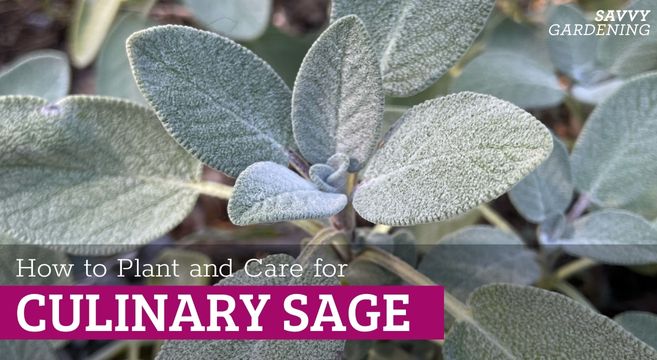This post may contain affiliate links. If you make a purchase through links on our site, we may earn a commission.
Sage is a highly fragrant herb that is a ubiquitous part of fall and winter flavors. If you’re growing an herb garden for the first time, you may be wondering, is sage a perennial? There are other Mediterranean herbs, like basil and rosemary, that are considered annuals in most growing zones. But sage is a hardy perennial, so don’t toss it in the compost at the end of the growing season! This is an herb that you can harvest almost year-round. In this article, I’m going to share some tips for planting sage, as well as advice on how to overwinter and prune your sage plant.
Sage is one of the many members of the extensive mint (Lamiaceae) family. I’m writing about common or culinary sage (Salvia officinalis), which for me evokes thoughts of stuffing and other hearty fall dishes.

Growing sage
While sage can be grown from seed, it’s pretty easy to find a young plant at the nursery. You can also propagate more plants from cuttings. My sage plants have been dug into the garden after making an appearance in containers. I love using the herbs in ornamental arrangements because the leaves are so textured and interesting.
Most common sage plants have leaves that are a silvery grey-green, which adds a lovely contrast among other annuals. There are also really lovely purple and tricolor varieties. At the end of the growing season, it’s easy to pop a sage plant into a sheltered part of the garden, where it should come back the following spring.
It’s recommended that sage be planted in full sun, but one of my plants thrives in a raised bed that gets a lot of dappled light throughout the day. A very ornamental plant, I recommend including sage in an ornamental perennial garden. Plant it in a border or even among low-growing perennials.
Of course you can also plant sage in an herb or vegetable garden. In her book, Plant Partners, Jessica recommends planting sage as a companion plant with cole crops (broccoli, cabbage, etc.) to interfere with cabbage worm butterflies laying their eggs.
Wherever you choose to plant your sage, make sure it’s placed in an area with well-draining soil after the last frost. Before planting, amend the area with organic matter. Sage plants do have a bit of drought tolerance, though they can start to look a bit haggard during extreme periods of heat.

Is sage a perennial in your growing zone?
Culinary sage is hardy down to USDA zone 5 (sometimes 4, depending on how protected the plant is) and up to about 10.
If your sage overwinters, in the late spring or early summer, it will produce gorgeous flowers that attract bees, butterflies, and hummingbirds. Unlike other herbs where the leaves taste a bit bitter after flowering, sage retains its flavor.
Apparently the flavor can wane, however, as a plant ages. So while a sage plant may persist, you may find the leaves don’t taste quite as strong as they used to. At this point you may want to introduce another sage plant to the garden.

Caring for a sage plant
A new plant will have green stems, but over time, sage plants can become a bit woody and gnarled. Pruning them helps to maintain a compact plant. It also prevents them from becoming too leggy. Using pruners, trim about a third of the plant to encourage fresh, new leaves. Try to avoid pruning on old wood as it won’t regrow. You can also trim the plant back again after it has flowered and the blooms have faded.

Garden sage isn’t really susceptible to many pests and diseases. It can be prone to powdery mildew (though there are mildew-resistant varieties), but it’s pretty uncommon. Make sure your plant gets good air circulation and the soil drains well to avoid root rot.
Harvesting leaves from your sage plant
If you’re heading out to the garden to harvest sage for a recipe, choose the newest leaves. Use a pair of scissors or garden shears to snip the leaves.
If you’d like to harvest leaves for your spice rack, you can snip a few stems to dry in bunches. I tie the ends with twine and hang mine from a curtain rod until they’ve dried out completely. Dried leaves are crushed and stored in jars.
Protecting your sage plant over the winter
While sage is winter hardy, if you’d like to protect the leaves for fresh harvests, you can provide a little insulation with evergreen boughs.
More herbs to plant in gardens and pots
- 10 herbs to plant in the fall
- Tips on growing parsley
- How to grow oregano for drying
- Advice for harvesting chives
- Sowing cilantro seeds




Should you do any pruning of sage in the fall?
Hi Anne, It’s best to wait until early spring!